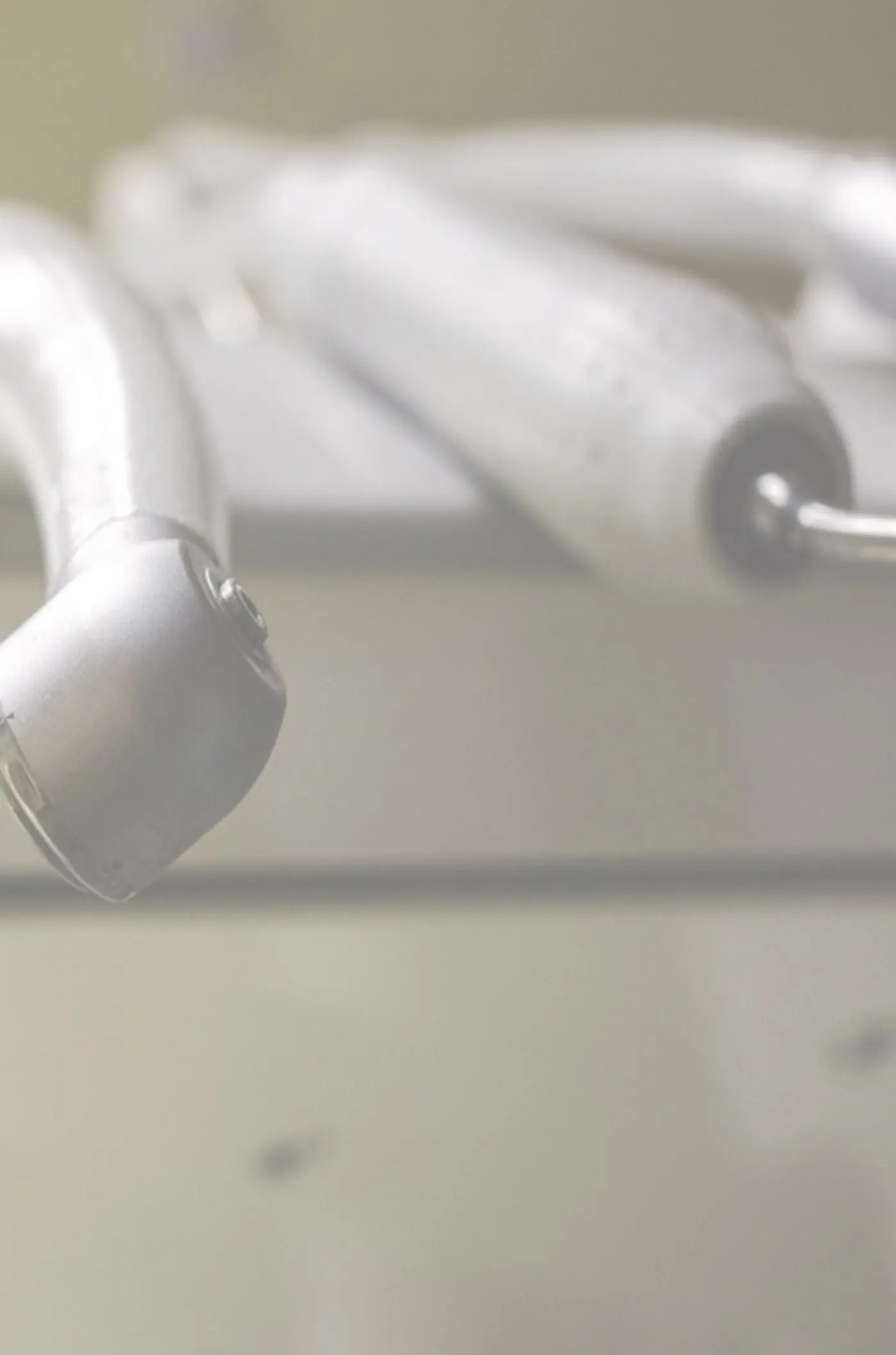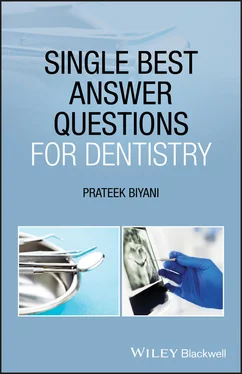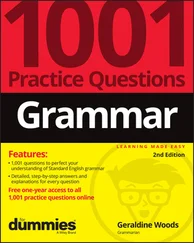
1 What is the ideal freeway space (FWS) for complete dentures?1–3 mm2–4 mm3–5 mm4–6 mm5–7 mm
2 Which of the following describes a Kennedy Class II, in Kennedy’s classification for partially dentate patients?Patient with bilateral free‐end saddlesPatient with a unilateral free‐end saddlePatient with a unilateral bounded saddlePatient with an anterior bounded saddlePatient with a bilateral free‐end saddle and a missing UR2
3 What is the primary purpose of indirect retention in partial denture design?Prevent displacement of the denture in the axial directionAid insertion and removal of the denturePrevent lateral forces on teethPrevent tipping/rotation of the denture about a fulcrumAllow for effective cleaning
4 A sclerosed canal can be more easily navigated using which of the following irrigants?ChlorhexidineSodium hypochloriteEthylenediaminetetraacetic acid (EDTA)WaterCalcium hydroxide
5 Which graph best describes the changes in plaque pH in response to food?The Miller CurveThe Monson CurveThe Stephan CurveThe David CurveThe Spee Curve 1.bThis is the ideal FWS. However, often, if patients have had a different FWS for a long period of time, it may be necessary to adhere to their existing FWS. This is primarily to ensure good habituation.2.bKennedy Class II is a unilateral free‐end saddle. It may also have modifications. It is only Kennedy Class IV that does not have any modifications, as the most posterior saddle dictates the class and, thus, any modifications would in fact fall in to a different class.3.dIndirect retention helps prevent tipping of the denture about a fulcrum created by the denture components. It can be provided by other denture components including clasps, rests and connectors.4.cEDTA is a chelating agent used to soften the dentine and allow easy exploration of sclerosed canals. Sodium hypochlorite is the typical irrigant for root canal treatments. Calcium hydroxide is better used in a pulpless, temporary dressing.5.cThe curve demonstrating plaque pH changes associated with snacking is the Stephan Curve. This helps demonstrate how frequent snacking causes the pH to drop below the critical pH more frequently. As a result, an individual is more likely to develop caries.
6 Which of the following is the advancing edge of a carious lesion in enamel?Dark zoneBody of the lesionSurface zoneTranslucent zoneZone of sclerosis
7 Which of the following is a crucial feature of amalgam cavity design?110° cavo‐surface anglePresence of unsupported enamelLeaving caries at the amelo‐dentinal junction (ADJ)Placement of pinsUndercuts
8 Which of the following best describes retruded contact position (RCP)?The position of the mandible, relative to the maxilla, when the teeth are maximally intercuspatedThe first tooth contact when the condyle lies in its most favourable position in the glenoid fossaThe position of the mandible when the condyle lies in its most favourable position in the glenoid fossaThe movement of the mandible during protrusive movementsThe movement of the mandible during lateral movements
9 Which of the following is not a feature of the ideal occlusion?Mutual protectionMolar guidanceAnterior guidanceRCP = ICPForces down the long axis of the teeth
10 A patient presents with pain brought on by hot/cold stimuli that settles shortly after the stimulus is removed. What is the likely diagnosis?Reversible pulpitisAcute irreversible pulpitisChronic irreversible pulpitisPeriapical abscessCracked tooth syndrome 6.dThe translucent zone marks the advancing edge of a carious lesion in enamel. This is then followed by the dark zone, the body of the lesion and finally the surface zone.7.eUndercuts are necessary for amalgam restorations as they rely on mechanical retention. A 90° cavo‐surface angle is needed to reduce the risk of fracture, due to thin amalgam sections, and caries should always be cleared from the ADJ.8.bRCP is the position where first tooth contact occurs with the mandible in centric relation, i.e. where the mandibular condyle lies in the most superior (comfortable) position in the glenoid fossa.9.bAn ideal occlusion should feature canine guidance, and not molar guidance, for lateral excursions. This protects the posterior teeth.10.aThis is a classic symptom of reversible pulpitis – pain settling once the stimulus is removed. The causative factor, for example a leaking restoration, needs to be corrected for symptoms to settle.
11 Which of the following is not a method of determining working length?Apex locatorPaper pointsPreoperative radiographWorking length radiographStep‐back technique
12 Which of the following irrigants helps remove the smear layer during root canal treatment?Sodium hypochloriteWaterChlorhexidineEDTASaline
13 Which of the following is not a contraindication for surgical endodontics?Persistent disease where non‐surgical treatments have failedPoor surgical accessUnrestorable toothUnderlying bleeding disordersNon‐surgical treatments are feasible
14 Which of the following is unlikely to cause insecurity of a complete denture?Overextension in the buccal sulcusLack of denture extensionBalanced occlusion and articulationExtension over the hamular notchThin post‐dam
15 Which of the following is a contraindication for veneers?Diastema closureFluorosisCamouflaging a canine as a lateral incisorPulpless teethGood oral hygiene 11.eStep‐back technique is a method of root canal preparation and not a method of determining working length.12.dEDTA helps remove the smear layer which allows irrigants in to the dentinal tubules. This allows more thorough chemo‐mechanical preparation.13.aPersistent disease, where standard treatment has failed, is the general reason for carrying out surgical endodontics. All the other options are common contraindications.14.cBalanced occlusion and articulation are the desired occlusal schemes with dentures and lead to best stability. All the other options are likely to lead to a lack of retention in some form.15.dPulpless teeth will generally continue to discolour over time and so the aesthetic value of a veneer will be lost. Careful consideration must be given to these teeth.
16 Which of the following would be an indication for crown placement?More conservative options availableSubgingival cariesGrade 2 mobilityHeavily restored toothRoot fracture
17 What is the ideal degree of taper for preparation of an indirect restoration?1–3°3–5°5–7°7–9°>9°
18 Erosion means loss of tooth surface tissue due to:Chemical processes independent of bacteriaChemical processes associated with bacteriaTooth‐to‐tooth contactDamage from foreign bodiesOcclusal forces
19 Which of the following is an indication for the use of rubber dam?Latex allergyClaustrophobiaDifficult accessAirway protectionImproving impression detail
20 What is the usual shoulder preparation for a metal‐ceramic crown?0.5 mm1.0 mm1.3 mm1.8 mm2.0 mm 16.dA heavily restored tooth, without any recurrent caries, would be an ideal candidate for a crown. If there is a more conservative management option then this should be attempted first. Extensive caries and periodontal disease are strict contraindications.17.cA taper of 5–7° is ideal to allow for optimal retention.18.aErosion occurs due to chemical processes independent of bacteria. Attrition is due to tooth‐to‐tooth contact and abrasion is due to foreign bodies (very commonly toothbrushing trauma).19.dAirway protection is critical in root canal preparation. Other indications include moisture isolation and improved visibility.20.cA general shoulder preparation of between 1.2–1.5 mm should be done to ensure adequate thickness and space for metal and porcelain.
Читать дальше


![Джон Скальци - Questions for a Soldier [Old Man's War 1.5]](/books/418139/dzhon-skalci-questions-for-a-soldier-old-man-s-wa-thumb.webp)










